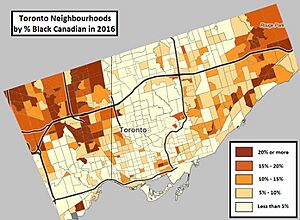Black Canadians in the Greater Toronto Area facts for kids
Black Canadians are a big part of the Greater Toronto Area (GTA). Most Black Canadians here have roots in the Caribbean. But the community also includes people from African American families (like Black Nova Scotians) and many African immigrants from countries like Somalia, Ethiopia, Ghana, and Nigeria.
Contents
A Look Back: History of Black Canadians in Toronto
Toronto's first Black community mostly lived in an area called St. John's Ward, which isn't there anymore. In the 1850s, about 1,000 Black residents lived in Toronto. Other nearby places like Oakville and York also had Black residents.
The number of Black people in Toronto went down to about 500 by the 1870s, as many moved to the United States. The population stayed low until the 1950s, when it grew to 10,000. Many of these early residents were born in Toronto or other parts of Southwestern Ontario. Their families often came from the Underground Railroad, a secret network that helped enslaved people find freedom.
In the 1960s, about 40,000 Black people lived in Toronto. This group included Black Canadians born in Ontario, immigrants from the Caribbean, and Black Nova Scotians. Black Nova Scotians often moved to the city with less education and fewer job skills, which made it hard for them to find work. Early Caribbean immigrants mainly came from Trinidad and Tobago and Barbados, but later, many more came from Jamaica.
In 1967, local Black Canadian leaders combined their celebration of Emancipation Day with traditions from the Trinidad and Tobago Carnival. This led to the start of Caribana, a huge festival.
The 1980s and 1990s saw many East Africans move to Toronto from countries like Somalia, Ethiopia, and Eritrea. More recently, Black immigrants to the GTA have come mostly from West Africa. Nigeria was one of the top countries for immigrants to Canada in 2019.
Where Black Canadians Live in Toronto
In 2016, about 442,020 Black Canadians lived in Toronto's Census Metropolitan Area. This area includes a big part of the GTA.
Here are some places in the GTA with more Black residents than the national average, based on the Canada 2016 Census:
- Ajax
- Brampton
- Pickering
- Toronto
- Whitby
- Mississauga
- Oshawa
- Milton
Many Black people in Toronto first settled in St. John's Ward, which was in the city center. Others chose to live in York Township, which was on the edge of the city. By 1850, there were many Black-owned businesses on King Street. Today, a similar area is Little Jamaica along Eglinton Avenue, which has one of the largest groups of Black businesses in Canada. First Baptist Church, started in 1826, is the oldest Black organization still running in the city.
Some Toronto neighborhoods like Jane and Finch, Rexdale, Malvern, Weston, St. James Town, and Lawrence Heights are often linked with Black Canadians. However, these areas are actually home to many different groups of people. The Toronto suburbs of Brampton and Ajax also have many Black residents. Many have moved there from Toronto in the last ten years. Ajax has the highest percentage of Black residents (16%) among Canadian cities with over 5,000 people.
It's important to know that income levels can be very different among various Black groups in the Toronto area. For example, in 2000, Barbadians had higher average incomes than Somalis in the Toronto area. This shows the wide range of experiences within the Black community.
Culture and Contributions
Black Canadians have made many important contributions to culture. In recent years, more TV shows like Drop the Beat, Lord Have Mercy!, and Da Kink in My Hair have focused on Black characters and communities.
Films by directors like Clement Virgo, Sudz Sutherland, and Charles Officer have shown Black Canadians on the big screen. Some notable films include Sutherland's ... and Eating the Bones, Officer's Nurse.Fighter.Boy, and Virgo's Rude and Love Come Down.
In literature, famous Toronto-based Black Canadian writers include George Elliott Clarke, Lawrence Hill, and Dionne Brand. Many new writers have also become well-known since the 1990s.
Since the late 1800s, Black Canadians have greatly influenced sports. In North America's major professional sports leagues, several Black Canadians from Toronto have had successful careers. These include Jamaal Magloire, Andrew Wiggins, P. K. Subban, and RJ Barrett. In track and field, Ben Johnson and Donovan Bailey were famous sprinters. Today, Andre De Grasse is a top sprinter.
The biggest and most famous cultural event is the Peeks Toronto Caribbean Carnival. This annual festival celebrates Caribbean Canadian culture and attracts millions of people every year. It shows the many different cultures within the African and Caribbean communities.
Black Canadians have also had a big impact on Canadian music. They have helped create many music styles, including Canadian hip hop, Canadian blues, Canadian jazz, Canadian Afrobeat, R&B, Caribbean music, pop, and classical music. Some Black Canadian musicians are famous worldwide, such as Dan Hill, Glenn Lewis, Tamia, Deborah Cox, Melanie Fiona, Kardinal Offishall, Drake, The Weeknd, and Tory Lanez.
While American Black culture is important, many African and Caribbean Canadians believe their own culture is unique. Experts often study how Black Canadian artists create a cultural space that is different from both mainstream Canadian culture and African American culture. For example, many Black-themed TV shows made in Canada focus on building Black-focused community groups.
Black activism also plays a role in Toronto.
See also
- List of Black Canadians
- African diaspora
- African-Canadian Heritage Tour
- List of topics related to the African diaspora
- Slavery in Canada
- Demographics of Canada
- Indigenous Black Canadians


